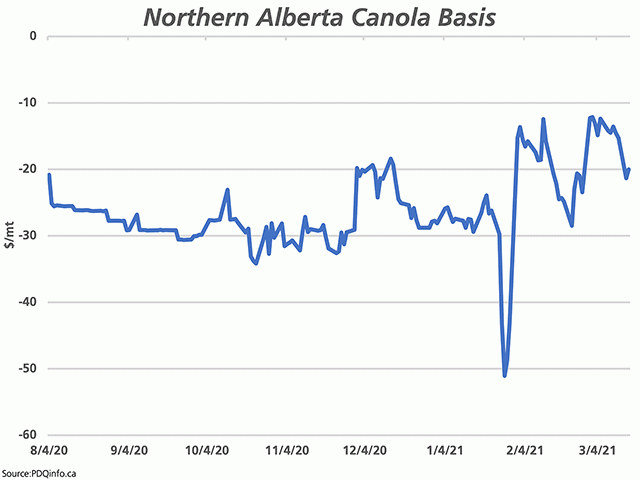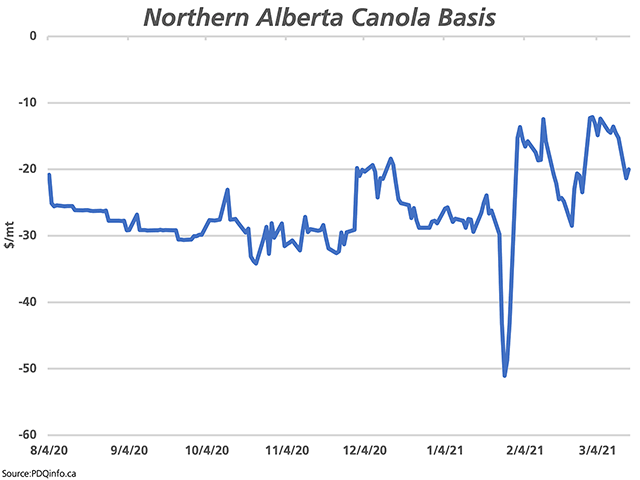Canada Markets
Prairie Canola Basis Signals Uncertainty
It is far too early to tell if this week is a turning point for global oilseeds. After three days of trade, soybeans have closed down 2.9% from their recent contract high, while poised for a second consecutive lower close on the weekly chart. The May soybean oil chart shows a 2% drop so far this week, poised for its first weekly loss in nine weeks. The May canola contract is down 3.9% from its high, poised for its first weekly loss in eight weeks.
Further weakness for May canola this week and trade below $770/metric ton, only $2.70/mt below the March 17 close, combined with a lower close over the course of the week, would signal a bearish outside reversal on the weekly chart and bears watching. Another signal is the weakening May/July spread or inverse, which has weakened $3/mt so far this week to $47.70/mt, signaling a less-bullish approach to trade.
The attached chart shows the reported basis for canola over the 2020-21 crop year for the northern Alberta region, as reported by pdqinfo.ca. Bear in mind this is the posted bid, while producers are likely to be accustomed to even more favourable pricing opportunities. This region was chosen due to the competitive nature of the area, with a combination of a reduced crop, increased competition from three crushers and new elevators competing for export business.
P[L1] D[0x0] M[300x250] OOP[F] ADUNIT[] T[]
While this chart looks similar to several other areas of the Prairies checked, what is interesting here is that pdqinfo switched to the May contract on Feb. 1 when basis was reported at $15.26/mt under the May contract, it fell to $12.44/mt under on Feb. 11, was as weak as $28.47 under by Feb. 22, strengthened to $12.13 under by March 2, then weakened again to $21.33/mt under by March 15, closing at $19.99/mt under on March 16.
Despite the tight fundamental situation facing the crop, there seems uncertainty as seen in the wild swings in basis during recent months. As well, the $19.99/mt basis reported on March 16 compares to the three-year average of $19.02/mt reported by pdq for the region, while only modestly stronger than the $20.69/mt basis which is the five-year average for this date.
The November contract is showing slightly more resilience, holding above the March 16 low up to the final minutes of the March 17 session, although falling to its lowest trade in four sessions by the end of the session. The November closed down 2% from its recent contract high.
The Nov21/Jan22 spread narrowed or strengthened this session to minus $0.80/mt, a weak carry that can be viewed as bullish overall when compared to the total cost of commercial carry. The November closed at $107.10/mt discount to the old-crop July contract, although prospects for a tight old-crop carry-out along with dry conditions on the Prairies should see this spread narrow over time.
PDQinfo.ca is currently reporting new-crop Sept/Oct delivery basis in the $16 to $17/mt range under the November contract in the northern Alberta region, which is a stronger basis than is currently shown in the spot market.
While current new-crop opportunities may look appealing and indeed a good price to start, the potential exists for improvements in both futures and basis for new-crop positions.
Cliff Jamieson can be reached at cliff.jamieson@dtn.com
Follow him on Twitter @Cliff Jamieson
(c) Copyright 2021 DTN, LLC. All rights reserved.






Comments
To comment, please Log In or Join our Community .